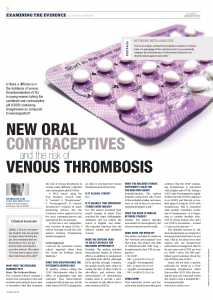 This article was published in Medical Observer.
This article was published in Medical Observer.
The article is also available on the Medical Observer website (may need registration).
Clinical scenario
Jenny, a 20-year-old university student saw me recently to enquire about starting the pill. She mentioned that her friend was on “Yaz”, but got worried when she looked it up on the internet. She asked, “Is it true that it causes more blood clots than other pills?”
Clinical question
Is there a difference in the incidence of venous thromboembolism (VTE) in young women taking the combined oral contraceptive pill (cOCP) containing drospirenone as compared to levonorgestrel?
What does the research evidence say?
Step 1: The Cochrane Library
The Cochrane Library contains a recent 2014 systematic review and network meta-analysis (up-to-date to December 2013) that examines the risk of venous thrombosis in women using different cOCPs. [1]
A PICO search using the TripDatabase (search term: P: “women”, I: “drospirenone”, C: “levonorgestrel”, O: “venous thrombosis”) resulted in many interested articles, but the Cochrane review appeared to the most contemporaneous and appropriate for our question. As this was a very comprehensive overview of many cOCPs, I will be focussing on just the comparison between drospirenone and levonorgestrel.
Critical appraisal
I will use the systematic reviews critical appraisal sheet from the Centre for Evidence Based Medicine. [2]
What PICO question does the systematic review ask?
In healthy women taking the cOCP (Participants); what is the effect of progestogen type and oestrogen dose (Intervention); compared with (i) non-use, and (ii) other types of cOCP (Comparator); on fatal or non-fatal first venous thrombosis event (Outcome).
Is it clearly stated?
Yes.
Is it unlikely that important studies were missed?
Yes. The authors described their search strategy in detail. They searched the major bibliographic databases, did not restrict the search to English, and manually searched reference lists the selected studies and identified reviews.
Were the criteria used to select articles for inclusion appropriate?
Probably. The authors included observational studies on adverse effects, in addition to randomised controlled trials (RCTs). Although RCTs provide stronger evidence, the authors justify their choice in noting the lack of these trials on side-effects, and evidence that meta-analyses of observational studies seem to provide a similar estimate of side effects risk to meta-analyses of RCTs.
Were the included studies sufficiently valid for the question asked?
Probably/Unclear. The authors formally assessed the risk of bias of the included studies, and many were at risk of bias in outcomes assessment (Figure 2, p. 9). [1]
Were the results similar between studies?
Unclear. The authors describe assessment for heterogeneity, but this isn’t reported in the results.
What were the results?
The authors included 25 studies in the “network meta-analysis” (see Stat Facts). The relative risk (RR) of ethinyloestradiol (EE) 30 μg + drospirenone for first VTE as compared to:
- No cOCP: RR = 3.9 (95% CI 2.7 to 5.5)
- 20 μg EE + levonorgestrel: RR = 1.7 (95% CI 1.1 to 2.7)
- 30 μg EE + levonorgestrel: RR = 1.6 (95% CI 1.2 to 2.1)
Conclusion
This systematic review and network meta-analysis provides good evidence that the cOCP containing drospirenone is associated with a higher risk of VTE. Taking a cOCP with levonorgestrel roughly doubles the risk of VTE (compared to no cOCP), and this risk is doubled again if using an cOCP with drospirenone. This is consistent with another systematic review just of drospirenone. [3]
It is important to consider absolute risks. VTE in young women who don’t use cOCP is uncommon – around 2-4 per 10,000 per year. [1, 4, 5] The absolute increase in risk from drospirenone as compared to levonorgestrel is less than 0.1% per year. Put another way, for around every 1500 women who use drospirenone rather than levonorgestrel, there will be one extra case of VTE per year (i.e., NNH ≈ 1500). The NPS published a good summary about the risk of VTE in new cOCPs. [6]
Jenny did not have a specific indication for being on a cOCP containing drospirenone rather than another cOCP. After discussing pros and cons (and costs!) she opted to start a standard EE + levonorgestrel pill.
Stat Facts
Network meta-analysis
This is an analytic method that evaluates networks of clinical trials. An advantage of this method is that it can potentially compare the effectiveness of interventions that were not directly tested against each other. [7]
References
- de Bastos M, Stegeman BH, Rosendaal FR, Van Hylckama Vlieg A, Helmerhorst FM, Stijnen T, Dekkers OM. Combined oral contraceptives: venous thrombosis. Cochrane Database of Systematic Reviews 2014, Issue 3. Art. No.: CD010813. DOI: 10.1002/14651858.CD010813.pub2.
- Systematic Review: Are the results of the review valid [MS Word document]? Centre for Evidence Based Medicine, University of Oxford. Last updated: 2008 Oct 1 (Retrieved: 2014 Apr 2) http://www.cebm.net/index.aspx?o=1157
- Wu CQ, Grandi SM, Filion KB, Abenhaim HA, Joseph L, Eisenberg MJ. Drospirenone-containing oral contraceptive pills and the risk of venous and arterial thrombosis: a systematic review. BJOG 2013; 120(7): 801-810. DOI: 10.1111/1471-0528.12210
- Lidegaard O, Nielsen LH, Skovlund CW, Skjeldestad FE, Lokkegaard E. Risk of venous thrombosis from use of oral contraceptives containing different progestogens and oestrogen doses: Danish cohort study, 2001-9. BMJ 2011; 343: d6423. DOI: 10.1136/bmj.d6423
- Samuelsson E, Hägg S. Incidence of venous thromboembolism in young Swedish women and possibly preventable cases among combined oral contraceptive users. Acta Obstet Gynecol Scand 2004; 83(7): 674-681. DOI: 10.1111/j.0001-6349.2004.00574.x
- Increased risk of thromboembolism in new oral contraceptives [website]. NPS Medicinewise. Last updated: 2013 Feb 14 (Retrieved: 2014 Apr 2). http://www.nps.org.au/health-professionals/health-news-evidence/2013/combined-oral-contraceptives
- Mills EJ, Thorlund K, Ioannidis JPA. Demystifying trial networks and network meta-analysis. BMJ 2013; 346: f2914. DOI: 10.1136/bmj.f2914
